10 Effective Strategies for Ecommerce Lead Generation in 2025

10 Effective Strategies for Ecommerce Lead Generation in 2025
Overview
The article outlines ten effective strategies for ecommerce lead generation in 2025. It emphasizes the importance of leveraging unique datasets, targeted marketing techniques, and interactive tools to capture leads. Each strategy, such as using AI-driven data, engaging pop-ups, and social media giveaways, is supported by statistics and case studies that demonstrate their effectiveness in improving engagement and conversion rates. This ultimately helps businesses connect with potential customers more effectively.
By utilizing AI-driven data, businesses can enhance their targeting efforts. The advantage lies in the ability to analyze consumer behavior patterns, leading to more personalized marketing. This results in higher conversion rates, as customers feel more understood and valued.
Engaging pop-ups serve as another strategy to capture leads. They can be tailored to provide relevant offers or content, capturing the attention of visitors. The benefit here is twofold: they increase engagement on the site and encourage visitors to share their information, thus expanding the lead pool.
Social media giveaways present an interactive approach to lead generation. By offering incentives, brands can encourage sharing and participation, significantly increasing their reach. This strategy not only enhances brand visibility but also fosters a sense of community among potential customers.
In conclusion, these strategies highlight the evolving landscape of ecommerce lead generation. By implementing these techniques, businesses can effectively connect with their audience, driving both engagement and conversion.
Introduction
The landscape of ecommerce is rapidly evolving, with businesses constantly seeking innovative ways to attract and convert leads. As competition intensifies, the need for effective lead generation strategies becomes paramount. This article delves into ten powerful techniques that can significantly enhance ecommerce lead generation in 2025, offering insights into leveraging unique datasets, engaging pop-ups, and targeted advertising.
However, amidst these strategies, one must ponder: what truly sets apart successful lead generation efforts from those that fall flat? Exploring this question will unveil the secrets to capturing high-quality prospects and transforming them into loyal customers.
Initial Data Offering: Access Unique Datasets for Targeted Lead Generation
Utilizing the Initial Data Offering platform presents companies with a diverse array of distinctive datasets tailored for ecommerce lead generation. The key feature here is SavvyIQ's AI-driven Recursive Data Engine, which enhances a dynamic graph of 265 million global entities. This allows companies to explore datasets that encompass consumer behavior and market trends, which enhances ecommerce lead generation by enabling them to identify potential opportunities with greater accuracy. For instance, ESG data empowers businesses to connect effectively with environmentally conscious consumers, aligning their marketing strategies with these consumers' values.
The advantage of this approach is underscored by the fact that 83% of consumers are more inclined to purchase from brands with which they feel an emotional connection. This statistic highlights the critical need for targeted marketing strategies. Furthermore, alternative data provides insights into emerging market segments, facilitating more informed targeting decisions. The benefit of applying such data is evident: it enhances prospect quality and boosts conversion rates, particularly through ecommerce lead generation by directing marketing efforts toward the most relevant audiences.
How can your organization leverage these insights? By integrating these unique datasets into your ecommerce lead generation strategies, you can enhance engagement with your target audience and drive better results.
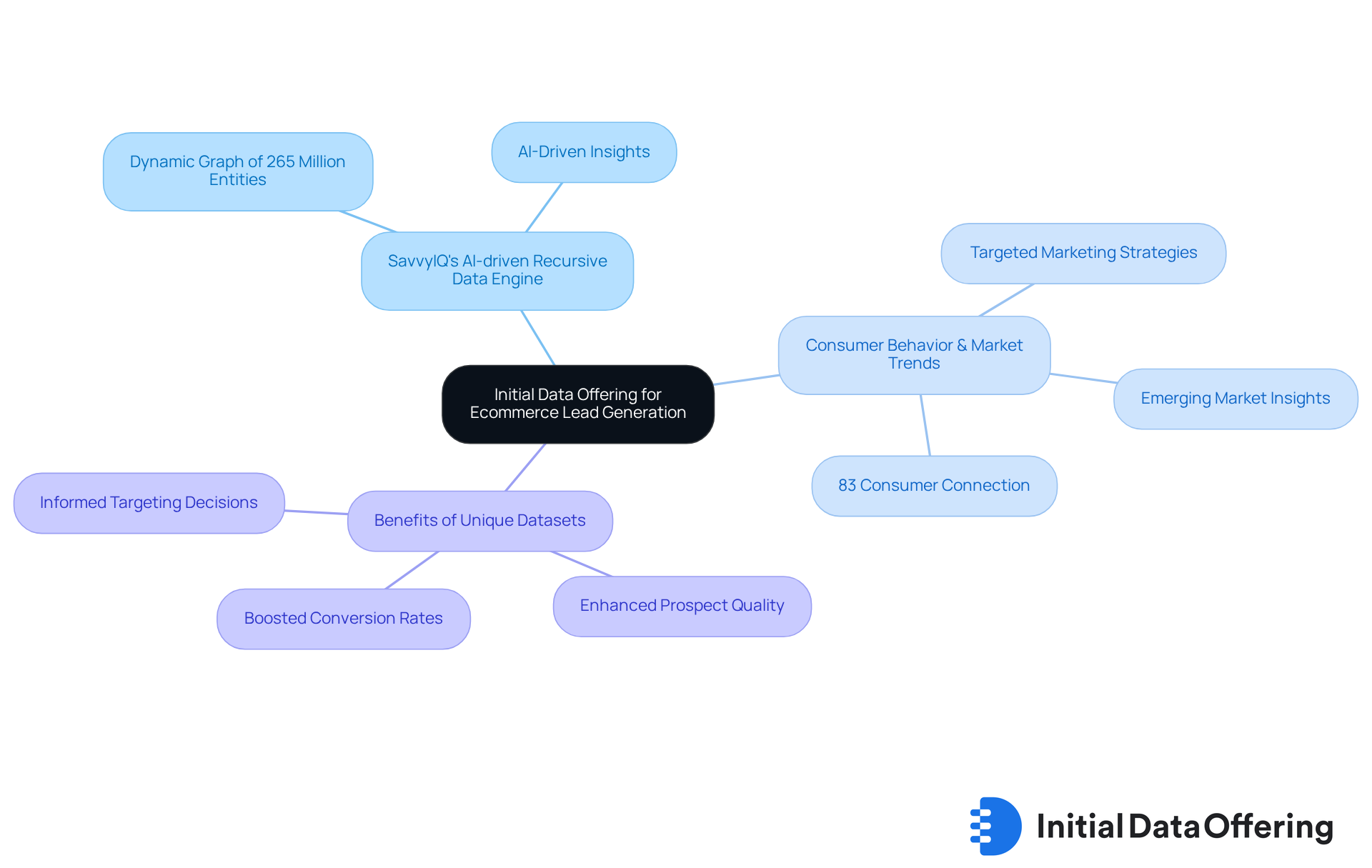
Wisernotify: Utilize Value-Driven Pop-Ups to Capture Leads
Wisernotify offers a platform designed for creating value-focused pop-ups that effectively attract prospects. These pop-ups feature incentives such as discounts, free trials, or exclusive content. The advantage of these incentives lies in their ability to encourage visitors to share their contact information, which is crucial for lead generation. Businesses can strategically time these pop-ups for ecommerce lead generation to appear when users show intent to exit the site, maximizing the opportunity to capture contacts.
Implementing A/B testing on different pop-up designs and offers can significantly enhance prospect acquisition efforts. By analyzing which variations yield the best results, businesses can optimize their strategies to improve engagement and conversion rates. Have you considered how these techniques could be applied to your own website? By leveraging Wisernotify's platform, you can create tailored experiences that resonate with your audience, ultimately driving growth and customer loyalty.
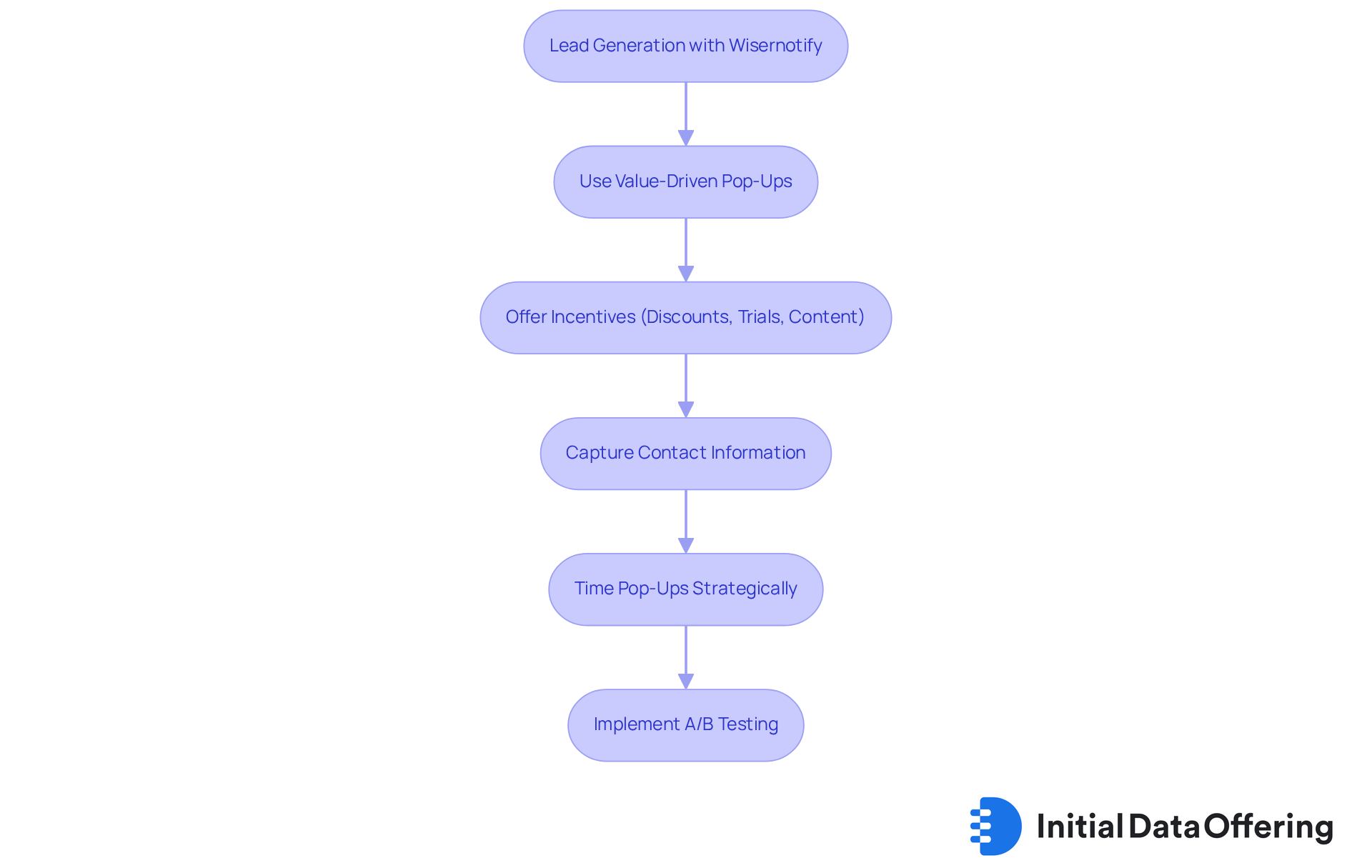
Transform Product Pages: Convert Visitors into Leads
Transforming product pages into effective tools for ecommerce lead generation involves strategically integrating:
- Capture forms
- Customer testimonials
- Engaging content
What if visitors could register for product updates or exclusive offers directly on the product page? This approach simplifies the customer acquisition process. Furthermore, showcasing user-generated content and positive reviews significantly enhances trust, motivating visitors to share their information. This dual strategy not only captures valuable prospects for ecommerce lead generation but also enhances the overall shopping experience, ultimately driving higher conversion rates.
For instance, companies that highlight customer endorsements often witness a notable increase in consumer confidence. In fact, 86% of users are more inclined to trust a brand that shares user-generated content, which directly influences client acquisition. Moreover, effectively incorporating capture forms can significantly boost engagement. Research indicates that 72% of businesses report that ecommerce lead generation is enhanced through content marketing, demonstrating the potential of well-optimized product pages. Thus, the integration of these elements is crucial for enhancing both trust and engagement in the digital marketplace.
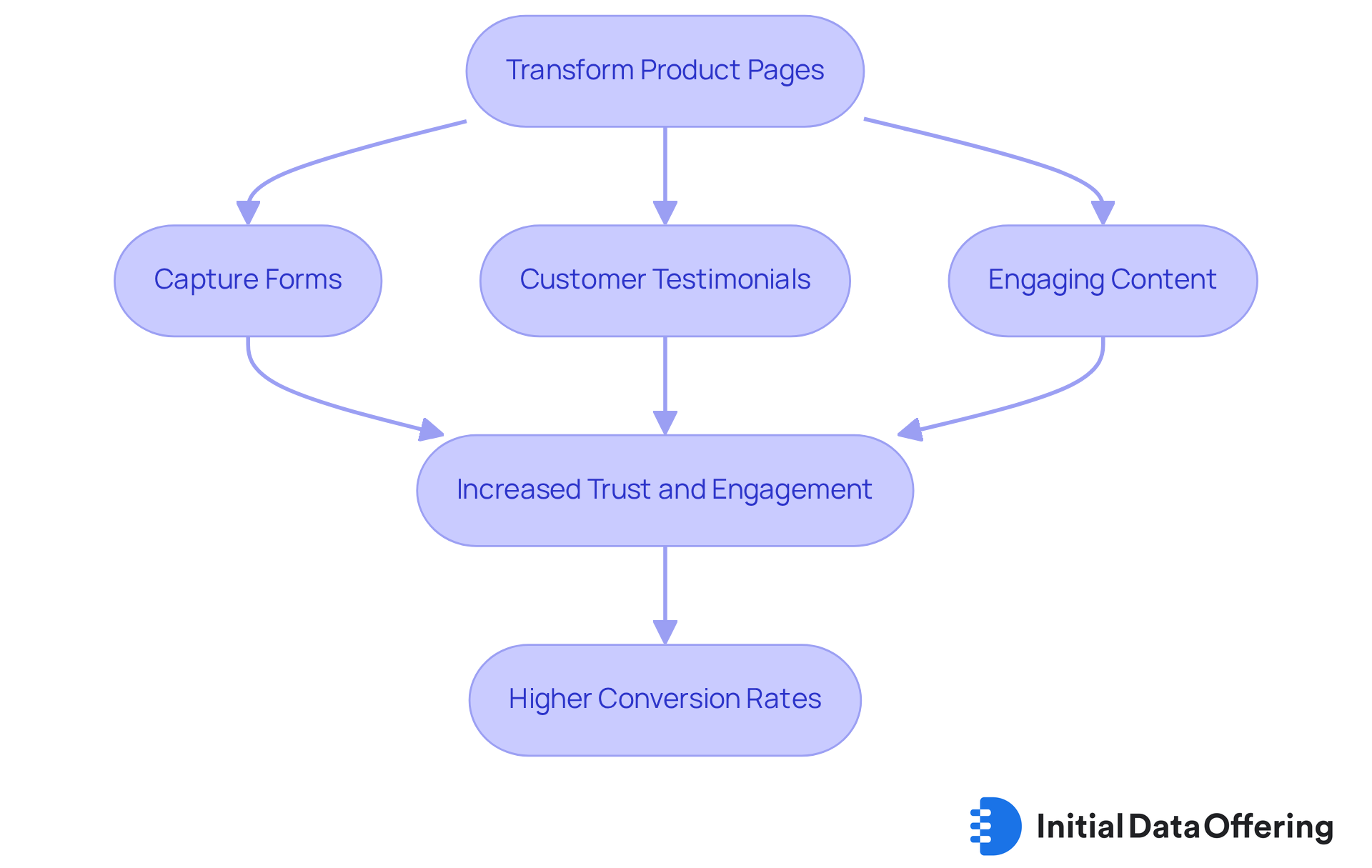
Engage Customers: Run Targeted Giveaways for Lead Generation
Running focused giveaways is a superb method for ecommerce lead generation, allowing businesses to engage prospective clients and gather contacts. By providing products or services that match the preferences of the target audience, companies can draw in valuable prospects. Utilizing social media platforms to promote the giveaway expands reach and encourages participants to share their contact information. Furthermore, requiring participants to follow the brand or subscribe to newsletters can significantly enhance ecommerce lead generation efforts.
The cost-effectiveness of social media marketing plays a crucial role in this strategy. It allows brands to reach a wider audience without significant financial investment. Engaging with other users' posts fosters relationships and extends brand reach, creating a more interactive community around the giveaway.
The effect of social media promotions on prospect capture is evident in various case studies. For example:
- Air Wick's gift-with-purchase sweepstakes effectively increased purchase intent and shopper engagement, demonstrating how instant rewards can drive participation.
- Kraft Heinz's retailer-specific sweepstakes transformed everyday purchases into exciting experiences, showcasing the potential of social media to enhance giveaway participation rates.
Engaging customers through social media giveaways can significantly boost ecommerce lead generation and amplify reach. By encouraging participants to share the giveaway with their networks, brands tap into new audiences and increase visibility. This strategy aligns with the finding that 68% of U.S. adults engaged in social media-based sweepstakes in 2023, emphasizing the effectiveness of these promotions in ecommerce lead generation.
To maximize the impact of social media giveaways, brands should concentrate on producing engaging material that resonates with their audience. Utilizing eye-catching visuals, storytelling, and influencer marketing can enhance engagement and encourage sharing. Additionally, continuously monitoring ad campaign performance is essential to optimize for maximum ROI. A well-structured customer acquisition strategy for ecommerce lead generation merges comprehension of the target audience with effective marketing methods, making social media giveaways an essential element in attracting new clients.
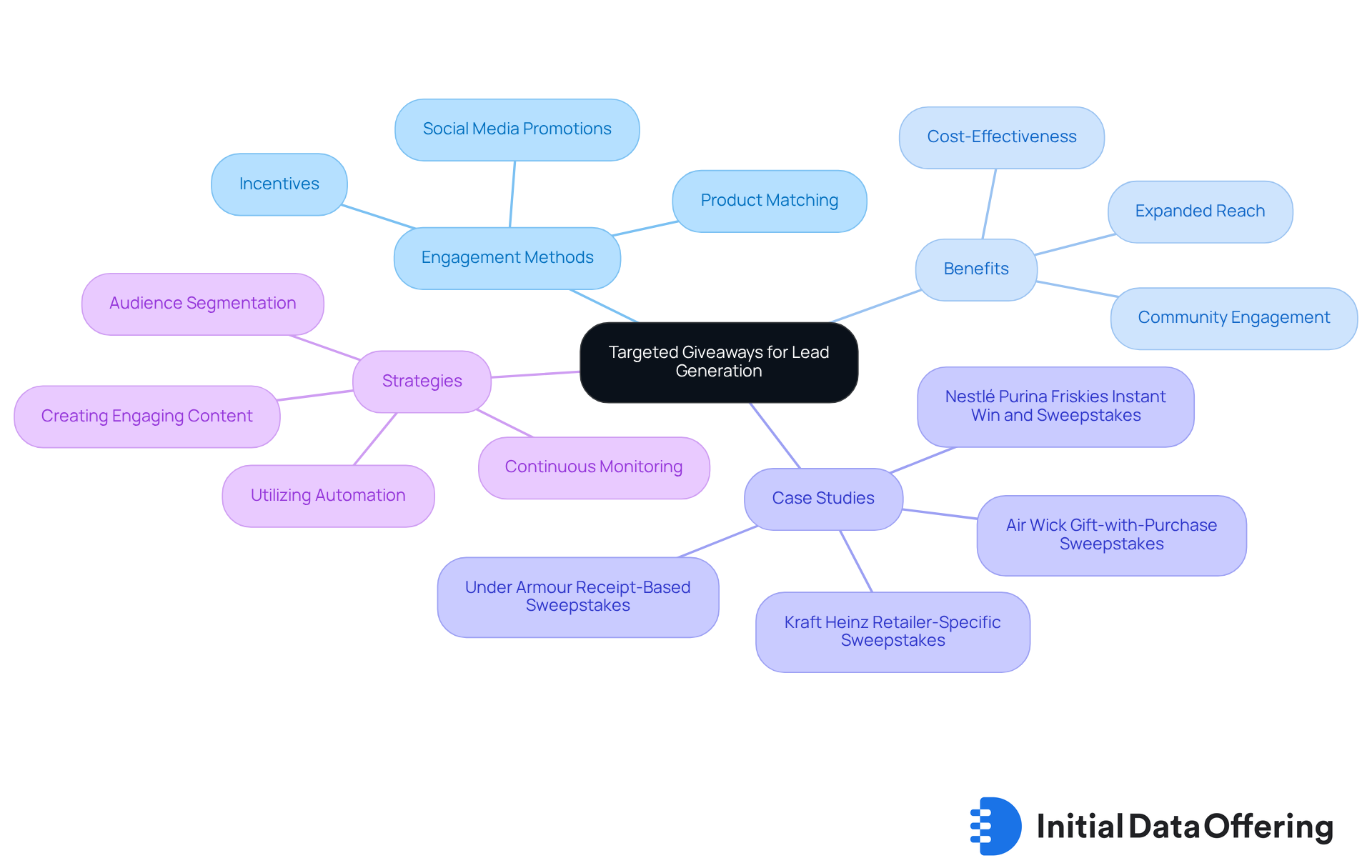
Content Creation: Address Customer Pain Points to Generate Leads
Producing material that addresses customer challenges is a highly effective strategy for ecommerce lead generation to acquire potential clients. By creating blog posts, videos, or infographics that provide solutions to common issues faced by the target audience, businesses can significantly enhance their ecommerce lead generation and improve customer acquisition efforts. For instance, 96% of B2B marketers consider content marketing successful in ecommerce lead generation for attracting quality prospects, and 76% utilize resources to achieve this. This data underscores the importance of well-crafted resources in the marketing landscape.
Incorporating clear calls-to-action within this content—such as encouraging readers to subscribe for more insights or download related resources—can further improve ecommerce lead generation by capturing potential clients. A case study featuring the Carpet and Rug Institute Blog illustrates this approach; initiated in April 2009, the blog achieved a positive ROI within six months by effectively addressing industry myths and showcasing success stories through engaging strategies.
Current trends indicate that blog posts with compelling material can significantly boost ecommerce lead generation and lead to higher capture rates. For example, 61% of B2B purchasers review three to seven pieces of content before engaging with a salesperson, which underscores the importance of ecommerce lead generation by providing valuable information that resonates with prospective clients. By focusing on customer challenges and offering relevant content, companies can improve their ecommerce lead generation, attracting more visitors and converting them into valuable prospects.
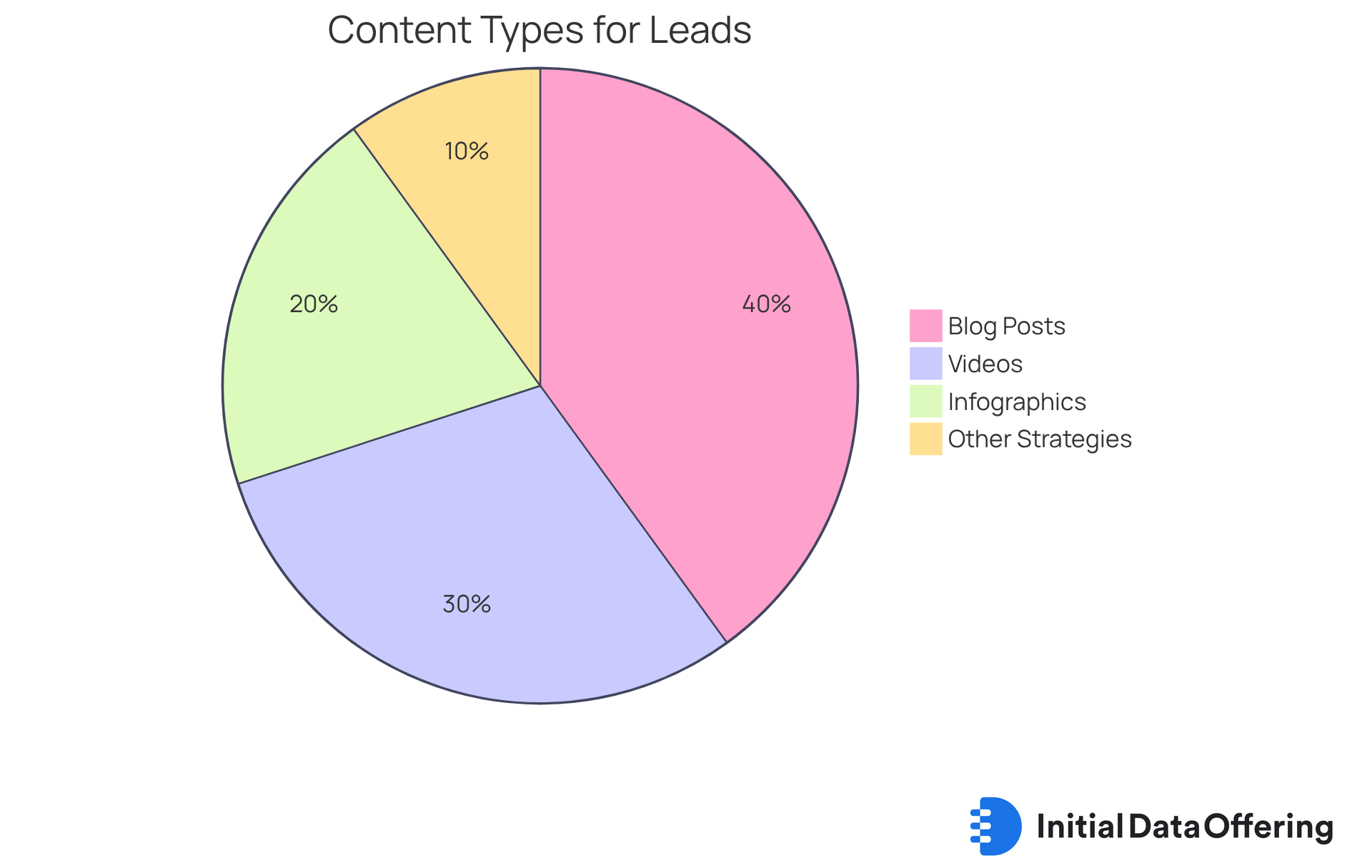
Interactive Quizzes: Guide Prospects and Capture Leads
Interactive quizzes serve as an effective tool for guiding prospects and enhancing ecommerce lead generation. These quizzes feature tailored results based on participant responses, which not only promotes engagement but also facilitates the collection of valuable contact details.
For instance, consider a quiz designed to assess a user's needs regarding a specific product or service. This approach not only captivates the user but also yields insights into their preferences, ultimately benefiting the business.
How can you leverage such quizzes in your marketing strategy?
- Promoting these quizzes through social media
- Email marketing can significantly enhance your ecommerce lead generation efforts.
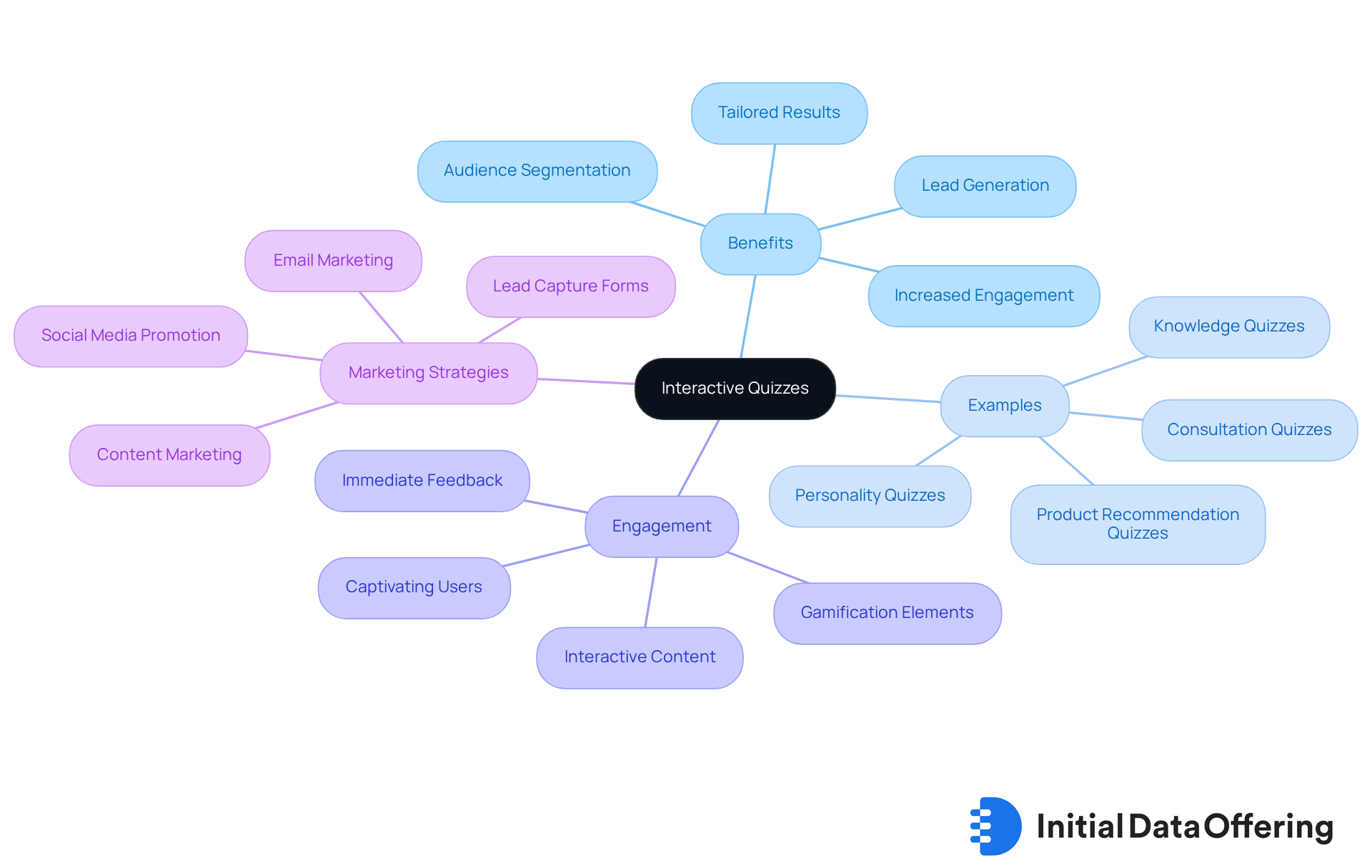
Email Marketing: Implement Effective Campaigns for Lead Generation
Executing successful email marketing campaigns is essential for ecommerce lead generation. By segmenting email lists based on customer behavior and preferences, businesses can improve their ecommerce lead generation by delivering personalized content that resonates with their audience. Research indicates that personalized emails can lead to a remarkable 50.8% increase in list growth rates, showcasing the effectiveness of tailored communication. Furthermore, a significant 76% of individuals expect to receive a welcome email immediately after subscribing, underscoring the necessity of timely and personalized outreach.
Regular newsletters that feature valuable insights, product updates, and exclusive offers serve to keep potential prospects engaged. A strong call-to-action (CTA) is crucial; it should instill a sense of urgency and clearly convey the value of taking the next step, whether that involves signing up for a webinar or making a purchase. Effective CTAs must address the question, 'Why should I?' for the reader, thereby enhancing the likelihood of conversion.
Current trends in email segmentation highlight the importance of understanding audience demographics and interests. By employing advanced segmentation methods, such as behavior-based targeting and journey mapping, companies can craft messages that resonate with specific groups. This strategic approach not only boosts user engagement but also nurtures stronger relationships with potential customers, ultimately driving sales success.
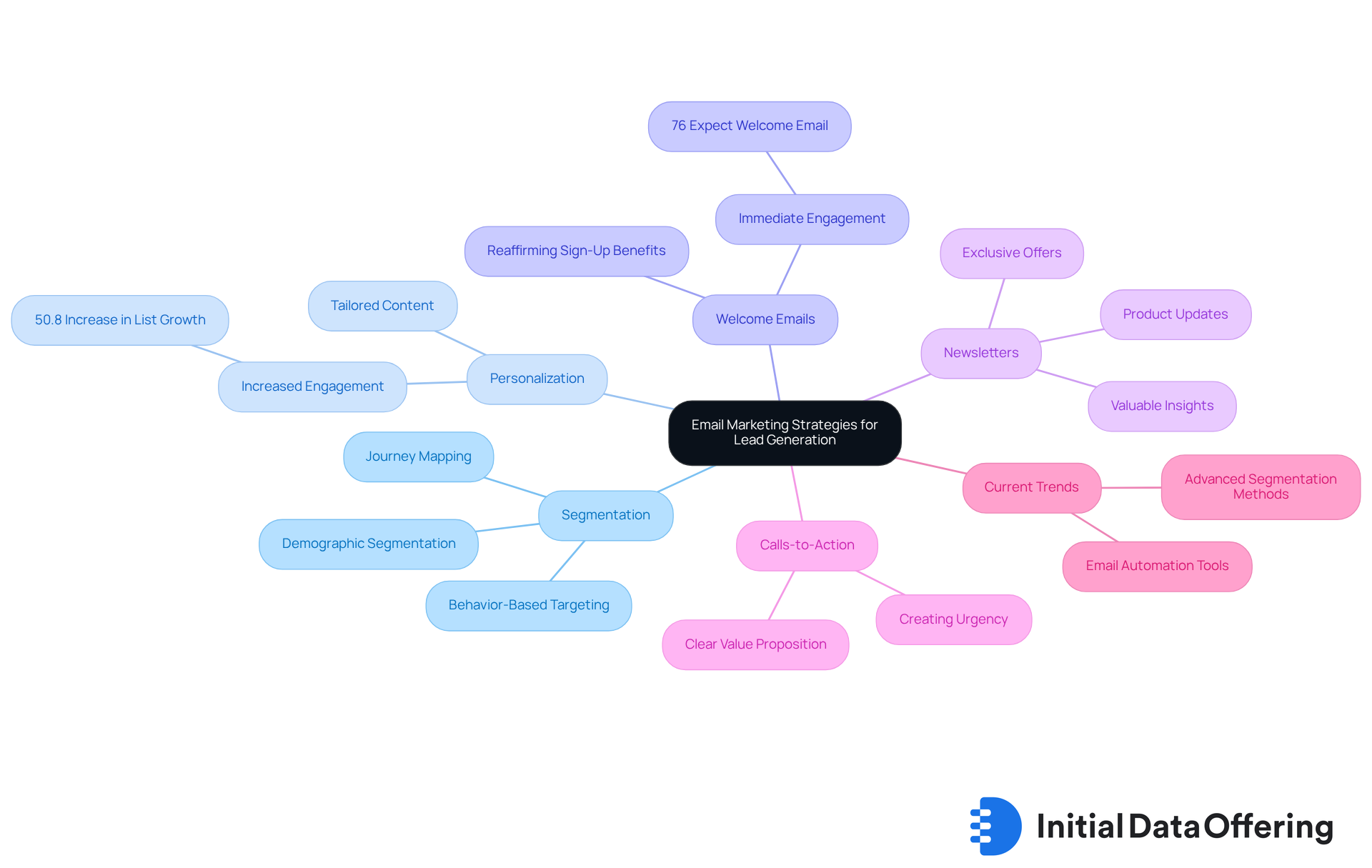
Google Ads: Target Leads with Focused Advertising
Utilizing Google Ads for targeted advertising presents a powerful feature that can significantly enhance prospect generation efforts. By concentrating on specific keywords linked to a business's offerings, companies can improve their ecommerce lead generation by attracting potential clients who are actively seeking solutions. A notable example is the transformation of National Industries Company (NIC), which experienced a remarkable 60% increase in organic traffic, underscoring the benefits of effective keyword strategies.
To maximize conversions, it is essential to create compelling ad copy and landing pages that resonate with the ad's message. This alignment not only enhances user experience but also encourages visitors to take action. Best practices dictate that the ad copy should reflect the content of the landing pages, ensuring consistency and relevance. Have you considered how your ad copy aligns with your landing pages? Furthermore, employing remarketing tactics can assist in re-engaging visitors who did not convert during their initial visit, providing another opportunity to secure potential customers.
As Brian Tracy emphasizes, approaching customers with the intent to help them solve problems is crucial for building trust and driving conversions. This approach fosters a deeper connection with potential clients. Integrating automation tools such as SaveMyLeads can further enhance prospect generation processes, ensuring that no potential opportunity is overlooked. In what ways can automation tools streamline your prospecting efforts?
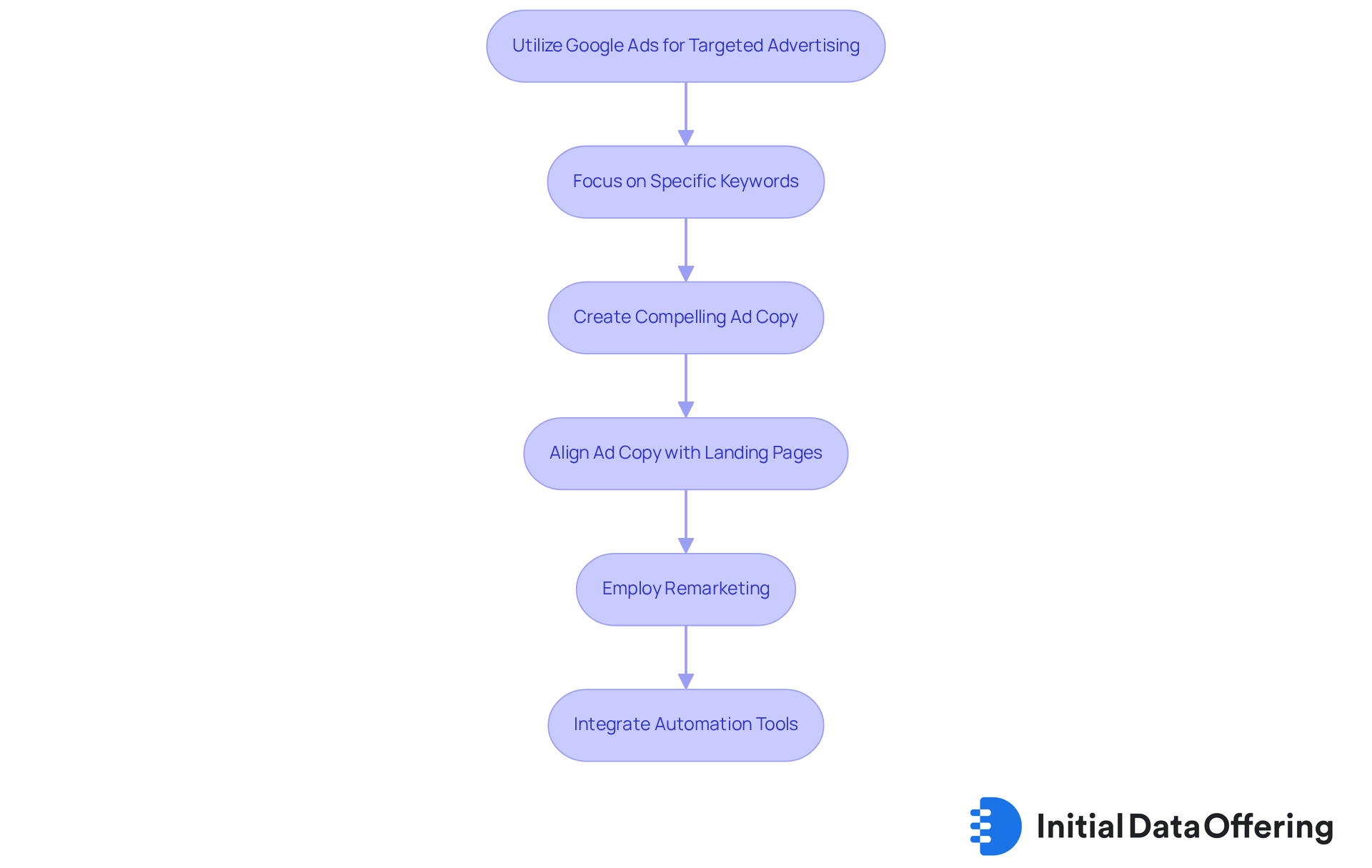
Facebook Ads: Capture First-Time Visitors as Leads
Facebook Ads serve as a powerful resource for ecommerce lead generation by converting first-time visitors into potential clients. By leveraging detailed targeting options, businesses can effectively reach specific demographics and interests that align with their products or services. This precision in targeting not only enhances the relevance of ads but also significantly boosts conversion rates. For instance, Facebook's vast user base of over 3 billion monthly active participants allows for extensive audience segmentation, enabling advertisers to tailor their campaigns to meet the unique needs of different groups. Notably, the average conversion rate for Facebook advertising stands at 12.54%, surpassing the benchmark of 10% for most paid advertisements on social media, further underscoring their effectiveness in generating prospects.
Designing visually appealing advertisements with persuasive calls-to-action is essential for motivating individuals to engage and share their contact details. High-quality visuals, minimal text, and engaging formats such as videos can effectively capture attention and drive interaction. A case study highlights that utilizing minimal text in visuals and incorporating videos can significantly enhance engagement and convey information effectively, thereby fostering trust with prospective clients. Moreover, running customer acquisition advertisements directly on Facebook streamlines the process for users, allowing them to complete forms with pre-filled information without leaving the platform. This seamless experience reduces the likelihood of abandoned submissions, as individuals only need to click 'submit' after their details are auto-filled.
The effectiveness of detailed targeting is further illustrated by case studies that show ads tailored to specific audience segments yield higher engagement and conversion rates. As Jessica Oliver notes, "When you conduct a Facebook advertisement campaign, Facebook users can complete forms without exiting the social media platform." By focusing on the appropriate audience, companies can optimize their return on investment and enhance the quality of prospects generated for ecommerce lead generation. However, it is crucial to acknowledge that Facebook advertisement forms may also lead to low-quality prospects due to accidental clicks or curiosity-driven sign-ups. As trends in demographic targeting evolve, staying informed about the latest tactics will be vital for improving prospect acquisition efforts on Facebook.
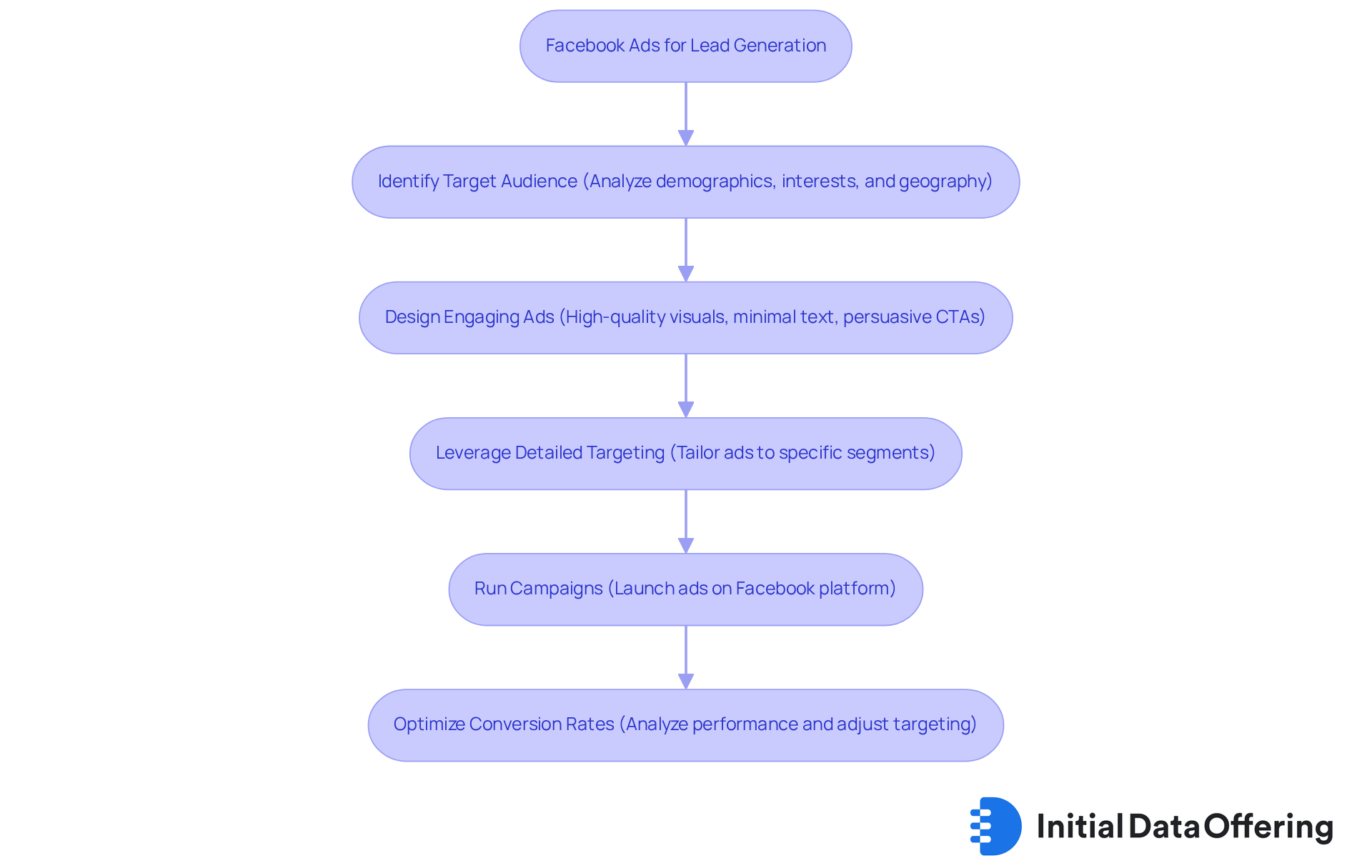
Chat Features: Guide Visitors and Capture Leads Effectively
Incorporating chat functionalities on ecommerce sites presents a significant opportunity for improving ecommerce lead generation efforts. Features such as real-time assistance allow businesses to engage visitors effectively and address their inquiries promptly. Advantages of this approach are underscored by current trends indicating that 64% of customers prefer to shop with companies that can meet their needs instantaneously, reflecting a growing preference for immediate communication. This prompt interaction not only enhances the user experience but also greatly increases the likelihood of securing potential clients.
Benefits arise from implementing chatbots for initial interactions, which facilitates efficient handling of inquiries. Human agents can then seamlessly take over for more complex questions, ensuring a smooth transition that can lead to higher conversion rates. A case study titled 'The ROI of Great Customer Service' emphasizes how exceptional customer service can enhance sales and customer loyalty, illustrating the tangible benefits of employing real-time chat solutions.
Moreover, with more than half of visitors accessing sites via mobile devices, ensuring that chat features are mobile-friendly is essential for maximizing accessibility and engagement. As ecommerce lead generation continues to evolve, leveraging chat features will be crucial for staying competitive and maximizing sales opportunities. How might your business benefit from these insights? Consider the potential impact of integrating chat functionalities on your customer interactions.
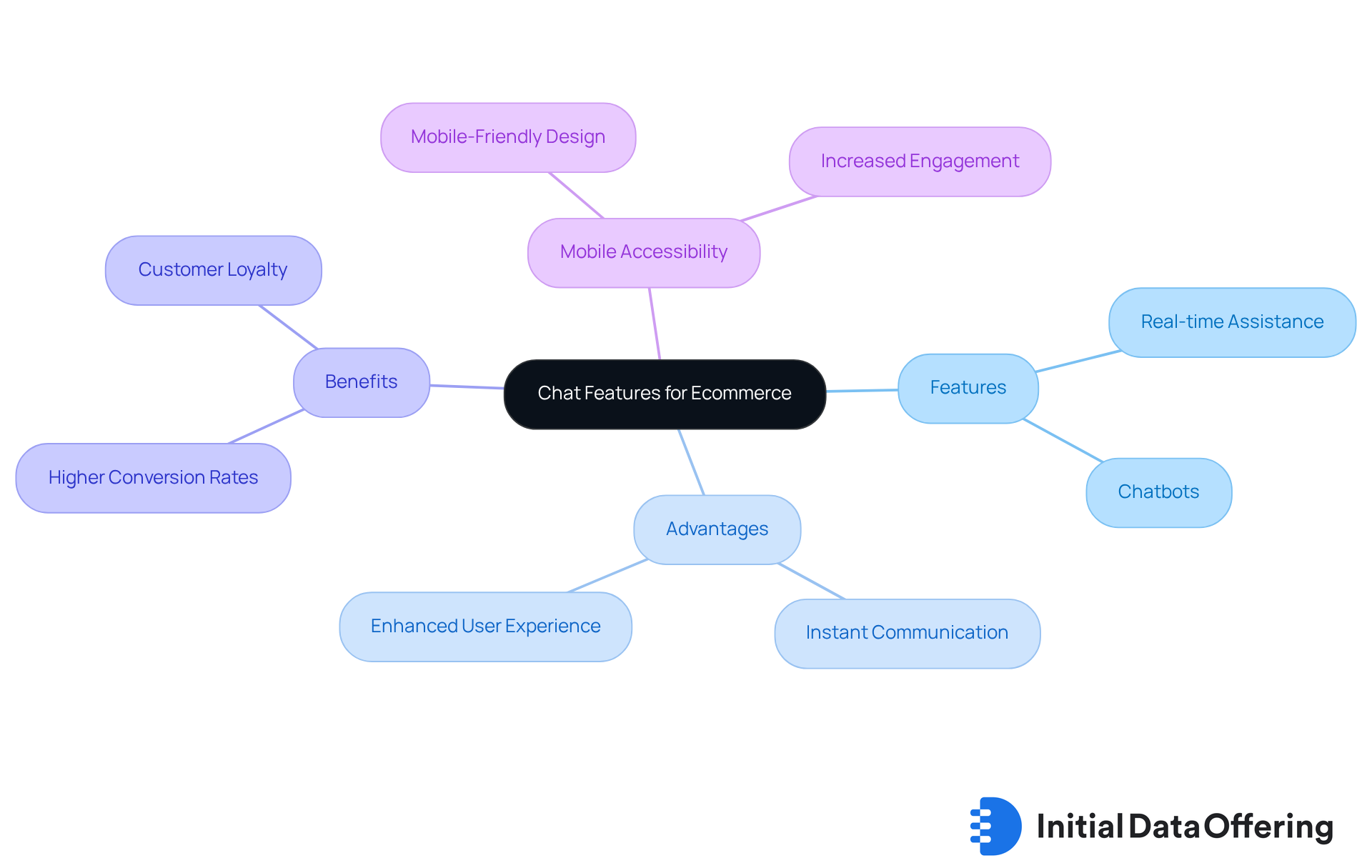
Conclusion
Implementing effective ecommerce lead generation strategies in 2025 is pivotal for businesses aiming to thrive in a competitive digital landscape. By leveraging innovative techniques such as unique datasets, interactive content, and targeted advertising, companies can significantly enhance their ability to connect with potential customers. These strategies not only focus on capturing leads but also emphasize the importance of creating meaningful interactions that resonate with the target audience.
Key points explored throughout the article include:
- The efficacy of initial data offerings for targeted marketing
- The power of value-driven pop-ups
- The transformation of product pages
- The impact of engaging giveaways
Each strategy contributes to a comprehensive approach that prioritizes understanding customer needs and preferences, ultimately driving higher conversion rates. Furthermore, integrating tools like interactive quizzes and chat functionalities enriches the customer experience, making it easier to capture valuable leads.
As ecommerce continues to evolve, embracing these strategies will be essential for businesses seeking to remain relevant and competitive. Companies should actively assess their current lead generation efforts and consider how these innovative techniques can be integrated into their marketing strategies. By doing so, they can foster deeper connections with potential clients, enhance engagement, and ultimately drive growth in the ever-changing ecommerce landscape.
Frequently Asked Questions
What is the Initial Data Offering platform and how does it help in lead generation?
The Initial Data Offering platform provides companies with unique datasets tailored for ecommerce lead generation, utilizing SavvyIQ's AI-driven Recursive Data Engine to explore consumer behavior and market trends, enhancing the accuracy of identifying potential opportunities.
How does ESG data benefit businesses in their marketing strategies?
ESG data helps businesses connect with environmentally conscious consumers, allowing them to align their marketing strategies with these consumers' values, which is crucial as 83% of consumers prefer brands they feel an emotional connection with.
What is the impact of alternative data on targeting decisions?
Alternative data offers insights into emerging market segments, facilitating more informed targeting decisions, which enhances prospect quality and boosts conversion rates in ecommerce lead generation.
How can organizations leverage unique datasets for better results?
Organizations can integrate unique datasets into their ecommerce lead generation strategies to enhance engagement with their target audience and achieve better results.
What is Wisernotify and how does it assist in lead generation?
Wisernotify is a platform that creates value-driven pop-ups featuring incentives like discounts or exclusive content, encouraging visitors to share their contact information, which is essential for lead generation.
How can businesses optimize their pop-up strategies using A/B testing?
By implementing A/B testing on different pop-up designs and offers, businesses can analyze which variations yield the best results, allowing them to optimize their strategies for improved engagement and conversion rates.
What are effective strategies for transforming product pages into lead generation tools?
Effective strategies include integrating capture forms, showcasing customer testimonials, and providing engaging content, which simplifies customer acquisition and enhances trust.
How does showcasing user-generated content influence consumer trust?
Highlighting user-generated content increases consumer confidence, with 86% of users more likely to trust a brand that shares such content, directly impacting client acquisition.
What role does content marketing play in ecommerce lead generation?
Research indicates that 72% of businesses believe ecommerce lead generation is enhanced through content marketing, highlighting the importance of well-optimized product pages in capturing leads.